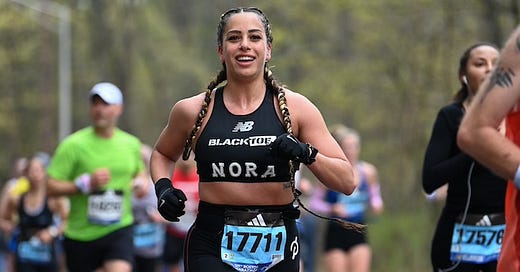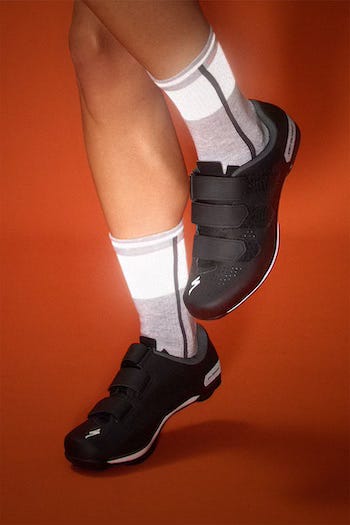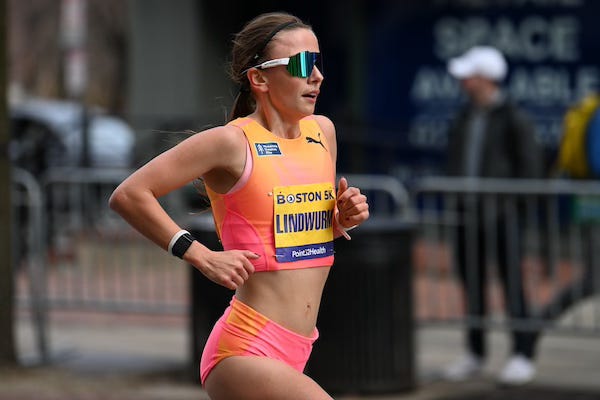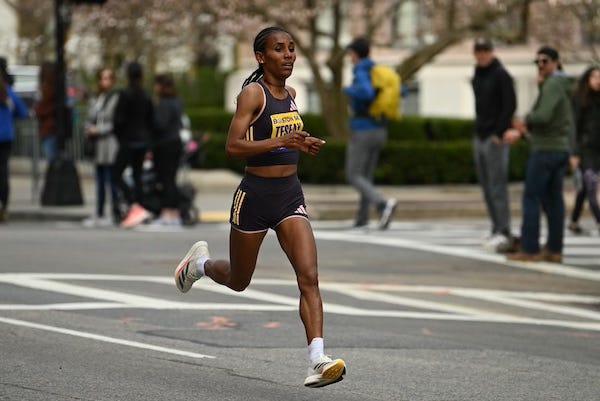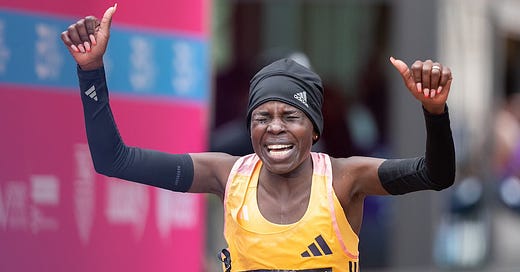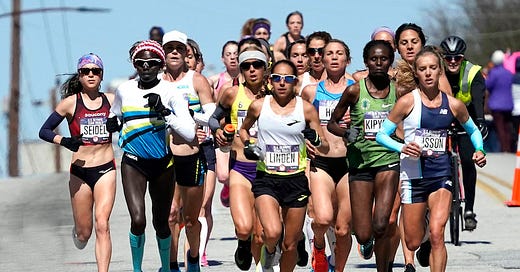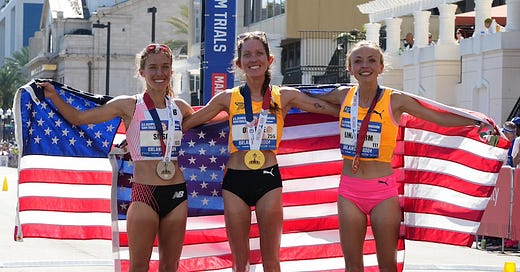

Discover more from Fast Women
Issue 287, sponsored by Bombas
To avoid covering the Boston Marathon a week after it happens, I’m planning to send out an extra issue of Fast Women, hopefully by tomorrow. This newsletter will return to its regular once-a-week schedule after that.
The good and the bad leading up to Boston
It’s Marathon Monday here in the Boston area, and later this morning, roughly 29,000 athletes will make their way from Hopkinton to Boston. If you’re one of those athletes, I hope you have a fantastic time out there today. This year’s event marks 100 years since the start of the Boston Marathon moved to Hopkinton, and the race distance became 26.2 miles, to match the Olympic distance. Until then, the race started a little closer to Boston, in Ashland.
Joan Benoit Samuelson, who won Boston in 1979 and 1983, will serve as the starter of the pro women’s division, to mark the 40th anniversary of her Olympic gold medal in the marathon. There are four returning champions in the pro women’s race: Hellen Obiri (2023), Edna Kiplagat (2017 and 2021), Des Linden (2018), and Caroline Rotich (2015).
Here are some storylines I’ll be thinking about today, and I can’t wait for others to unfold:
Hellen Obiri and Sharon Lokedi will be racing for spots on Kenya’s Olympic squad. A win here would give them a good shot, but with three more contenders racing London next week, nothing is guaranteed. Obiri comes in as the pre-race favorite, but she’ll have a lot of competition.
Emma Bates, Sara Hall, and Caroline Rotich are among the top Americans in the field. Bates says she’s feeling great after recovering from the injury that kept her out of the Olympic Trials, and Hall and Rotich will be doubling back after finishing fifth and sixth, respectively, at the Trials. You can never count out Des Linden, especially in Boston, and Jenny Simpson says she’s going to finish this race and become a marathoner, no matter what, after dropping out of the Trials.
I love when pros use their races to promote good causes. Hall turns 41 today, and she is raising money to provide microloans to women living in poverty in Ethiopia. She talked more about her motivation in this video. And she’s matching all the donations she receives until she hits her $50,000 goal.
Switzerland’s Manuela Schär will be looking to earn her fifth Boston Marathon victory in the wheelchair race.
One big story that hasn’t made its way into the B.A.A.’s daily media recaps is the news that on Thursday, Lawyers for Civil Rights filed a lawsuit on behalf of the TrailblazHers Run Co., alleging that the B.A.A. and Newton police targeted its members and made them feel unsafe and unwelcome at last year’s marathon. You can read the full lawsuit here. One of TrailblazHers’ founders, Liz Rock, will be running today’s race.
“I am very confident that our cheer zone is the most diverse along the course, and I know we provide our runners with something special, so I thought, ‘Damn, I want to be on the other receiving end of that,’” Rock told Outside Run, in an article that has since been deleted from the outlet’s website. “In my head, it was going to be like killing a couple of birds with one stone because I’m going to get to experience mile 21, and on the other end, it’s going to be like a protest in my head [in response to what happened last year].”
In the same article, Sidney Baptista, founder of the PIONEERS Run Crew, told Emilia Benton that his crew still plans to have a cheer zone along the Boston Marathon course this year.
PIONEERS is the organization behind the 26.TRUE Marathon, which took place in Boston on Saturday. This year’s 26.TRUE race had a little extra star power with Boston Mayor Michelle Wu serving as the race’s starter and Molly Seidel running a good chunk of the course. Seidel’s sponsor, Puma, also sponsors the race, and they put out this reel after the race. The Boston Globe also published a great article on the event and this Outside Run piece has more about the event’s history.
I was able to stop by one of the cheer zones for a bit between the B.A.A.’s 5K and mile on Saturday morning, and seeing the support for the runners as they passed through was the highlight of my day. The bubbles and confetti, both of which are not allowed if you’re spectating at today’s race, were a nice touch.
And one more thing that won’t make the B.A.A.’s list of storylines tied to this year’s race is the news that 10 years after winning the 2014 Boston Marathon, Ethiopia’s Buzunesh Deba is still waiting to receive the $100,000 that the B.A.A. owes her. Rachel Bachman broke this news in The Wall Street Journal on Friday.
Rita Jeptoo crossed the finish line first that year, but she was disqualified for doping in 2016. The B.A.A. owes Deba $75,000 for the prize money difference between first and second place, as well as a $25,000 course record bonus. The B.A.A. says they’re still trying to reclaim it from Jeptoo, which seems unlikely ever to happen. Deba was invited to participate in this year’s race, to mark the 10-year anniversary of her win, and she declined the offer. She still holds the course record of 2:19:59.
But in more positive Boston Marathon news, after putting a long-overdue pregnancy and postpartum deferral policy into place last year, the B.A.A. granted 187 pregnancy and postpartum deferrals this year, The Boston Globe reports. And of the 112 runners who deferred their entries last year, 55 are running the race this year.
How to follow today’s race
In the U.S. today’s race will be broadcast on ESPN2 nationally and WCVB in the Boston area. More details here.
Helpful links: Start lists | Uniform guide | Live results (also available in the B.A.A. Racing app)
Select start times:
9:02 a.m. ET Men’s wheelchair
9:05 a.m. Women’s wheelchair
9:37 a.m. Pro men
9:47 a.m. Pro women
9:50 a.m. Para Athletics division
10:00 a.m. Wave 1
10:25 a.m. Wave 2
10:50 a.m. Wave 3
11:15 a.m. Wave 4
Thanks to Bombas for supporting Fast Women this month
As a runner, staying visible when it’s dark out is so important. I recently took the new Bombas Reflec-Tec socks–complete with reflective yarns!–for a test run, and there’s no question that they helped me stand out more to the drivers in my neighborhood. (I haven’t tried it out, but I think they’d be great for cycling in low light too, or even just walking the dog.) The slouch-resistant fit is also perfect, and I love how my feet never feel sweaty in them.
As with all Bombas products, for every sock you purchase another is donated to someone experiencing homelessness. While I have received products from Bombas, my opinions are solely my own. Whether you’re an early morning or nighttime jogger, or just want some cool running socks, use code FASTWOMEN21 to get 21% off at Bombas.com. For new customers only and one use per customer, offer expires 5/6/24.
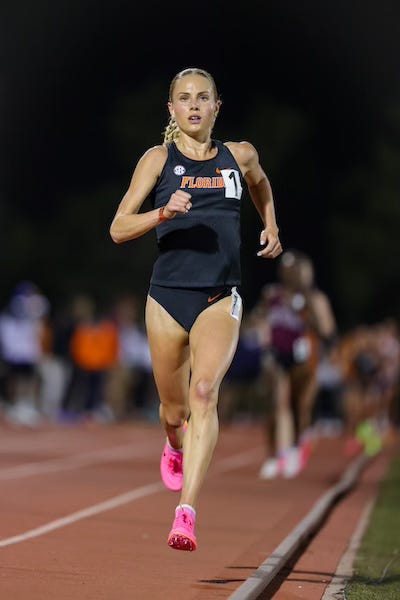
In her 10,000m debut, Parker Valby takes down another collegiate record
To no one’s surprise, it turns out Parker Valby, who has won four NCAA titles in the past year, is good at the 10,000m too. Valby made her debut at the distance at the Bryan Clay Invitational, hosted by California’s Azusa Pacific University, on Thursday evening and broke Lisa (Koll) Uhl’s 14-year-old collegiate record.
Calli Hauger-Thackery paced Valby through 5,000m in roughly 15:30 before exiting the race. Just before halfway, Valby began lapping her competitors. When Hauger-Thackery dropped, Valby picked up the pace. Her fourth mile, which she ran in about 4:49, ended up being her fastest of the race. But she backed off the pace over the next two miles.
With just over five laps to go, Valby had lapped the entire field. She powered to a 30:50.43 finish and took 27 seconds off the 31:18.07 Iowa State’s Uhl ran in 2010. Valby negative-split the race, running 15:20 for the second half. She’s now the 11th-fastest U.S. woman of all time in the 10,000m, and most of the women ahead of her had more competition.
Considering that she beat her next closest competitor by more than two minutes, Valby came impressively close to the Olympic standard of 30:40. Currently, only two U.S. women have the 10,000m standard: Alicia Monson and Weini Kelati. But over the weekend, Monson shared that she underwent surgery last Wednesday to repair a complete root meniscus tear, and the surgery requires a long recovery. This means Monson will miss the Olympic Trials in June.
It’s a massive blow for Monson, who was favored to make the team in the 5,000m and 10,000m, but it will likely open up an opportunity for someone else. There are other U.S. women who have the talent and fitness required to break 30:40, so I’m looking forward to finding out who, if anyone, can pull it off before the Trials. Valby is at a disadvantage because she presumably needs to prioritize the collegiate season until early June. (10,000m replay | 10,000m results)
Michaela Rose leads a slew of other fast performances at Bryan Clay
One year ago at the Bryan Clay Invitational, Nikki Hiltz dramatically nipped LSU’s Michaela Rose at the line in the 800m, and Rose finished second in a PR of 1:59.08. This year, Rose was alone the entire race. She built enough of a lead that FloTrack decided to use a split screen to show Rose in one frame and the chase pace in the other, mid race. Rose won the race in 1:58.37 and took 0.71 seconds off of her PR. Among runners in the NCAA, only Athing Mu has run faster than Rose. Anna Camp Bennett finished second, in 2:01.14. (800m replay | 800m results)
Alabama’s Hilda Olemomoi looked fantastic in winning the Bryan Clay 5,000m in 15:06.42, which makes her the second-fastest collegian ever outdoors, behind only Katelyn Tuohy. Olemomoi sat behind Abbey Cooper until her coach yelled something at her with less than 300m to go. At that point, she made the pass and opened up a 4.73-second lead by the finish. Cooper finished second in 15:11.15, and Amanda Vestri finished third in 15:13.38, a PR.
Emily Infeld ran well for 4500m, sticking with Olemomoi and Cooper. But when she faded, it was pretty dramatic. She finished ninth in 15:20.54, which doesn’t really tell the story of her race. Across the four different invitational heats, 59 women broke 16:00. And remember Zoe Baker, whom I profiled a few weeks ago? She skipped the Olympic Marathon Trials to run her final season of track for the Colorado School of Mines, and her big goal was to break 16:00. She pulled it off, running 15:58.60. (5,000m results)
BYU’s Lexy Halladay-Lowry, who is redshirting the outdoor track season, ran an impressive 9:26.55, a four-second PR, to win the steeplechase. If she wasn’t redshirting, that would have placed her sixth on the NCAA all-time list. And Gracie Hyde of Adams State continued rewriting the DII record books with her runner-up finish in 9:28.17, a massive PR. Hyde also broke the DII 1500m record two days later, running 4:08.95. I’ve seen some people saying of course Hyde is breaking DII records, she came from DI. (She ran for Arkansas until this academic year.) But if you click on the progression tab here, you can see she has gotten much faster this year. (Steeplechase results)
In outdoor track, collegiate distance runners tend to flock to the California meets because of their consistently good weather. The first two days of this meet were nice, but on the third day, during the fastest heats of 1500m, it was pouring rain. Running in separate heats, Dani Jones (4:07.19) and Anna Camp Bennett (4:07.33) ran the fastest times of the day. The fastest collegians were Georgetown’s Melissa Riggins and Washington’s Chloe Foerster. Both ran 4:07.96, but Riggins’ time was four thousandths of a second faster, so she now leads the NCAA. (1500m results)
Three Olympians who are returning from setbacks also competed at Bryan Clay. Elise Cranny raced for the first time this year, finishing fifth in the top heat of the 800m in 2:02.90 and eighth in the top heat of the 1500m the following day, running 4:09.65. Two weeks after running 2:03.15/4:14.20 at Raleigh Relays, Heather MacLean improved her 1500m time to 4:08.64. And running her first race since having ACL surgery, Val Constien had a great kick to win her heat of the 1500m in 4:12.27.
Nike’s unveiling of Olympic kit takes an unexpected turn
Nike unveiled its Olympic uniforms on Thursday at an event in Paris, and I don’t think they got the reaction they were hoping for when they showcased what the women’s track & field athletes from the U.S. will be wearing. The women’s bodysuit, as modeled by a mannequin, does not offer much coverage in the crotch. This Citius Mag post kicked off the skewering.
My hope is that it’s not as bad as it seems. Katie Moon modeled what she believes is the same style, and it provided a lot more coverage for her than it did the mannequin. On the other hand, Nia Ali posted in response, “Katie girl it don’t fit like that on me.” It will be interesting to see what other athletes have to say, particularly ones who aren’t financially motivated to stay on Nike’s good side.
All the athletes have a choice of uniforms, but it will be a problem if an athlete prefers a certain type of uniform but can’t wear it because it’s too revealing. Track & field’s uneven norms as far as what men and women tend to wear while they compete are not Nike’s fault. But even if things aren’t as bad as they seem, someone should have looked at the mannequin photo and thought better of sending that out into the world.
People’s reactions on the Citius post were hilarious. Some of my favorites:
@oiselle: “When you run out of fabric after designing the men’s kit…”
@mandymovez: “We’ve seen the front 🫣…can’t imagine what the back looks like 👀”
@_kxnaomi: “This the real reason why people be switching countries.” (Though I suspect athletes from other Nike-sponsored countries are going to have uniform options with the same cut.)
@goqueengo: “Hi @europeanwax would you like to sponsor Team USA for the upcoming Olympic Games!? Please and thanks.”
@kelseys023: “Is she supposed to stop mid race to tuck her coozy back in??!”
@sisterhoodofsteel: “My labia fighting for which one gets to be in the suit.”
And Laura Green’s Instagram reel that poked fun at the design was great.
Lauren Fleshman told The New York Times (gift link) that she’s glad Nike put the image out “as the crown jewel of Olympic Team design,” because it might lead some people to further question the norms in track and field. “If you showed this outfit to someone from the WNBA or women’s soccer, they would laugh in your face,” she said.
It’s great that Olympians have many uniform options, but that doesn’t always trickle down to the college and high school level. I once worked with a coach who feared that letting the female athletes on his team wear less form-fitting options would lead to them “letting their bodies go.”
Allowing athletes to compete in uniforms that make them feel comfortable should come first, and time will tell whether Nike’s latest Olympic uniforms do the job. In the meantime, I think it’s great that people are giving the topic a little more thought. My mind always goes back to what Fleshman said on Nobody Asked Us last year: If wearing briefs made athletes faster, Eliud Kipchoge would have done so during his sub-2:00 marathon attempts.
The Diamond League is about to get a lot more expensive and inaccessible
The new Nike uniforms weren’t the only announcement that got a big reaction from the running world last week. On Wednesday, FloTrack announced that starting in 2025, the Diamond League, minus the Prefontaine Classic, will stream exclusively on FloTrack in the U.S. As far as I could tell, only FloTrack was excited about this news.
In recent years, Diamond League meets have been televised on NBC and/or streamed on Peacock, which costs $5.99/month or $59.99/year. (Or just $19.99/year if you took advantage of their Black Friday deal.) FloTrack, on the other hand, costs $29.99/month or $149.99/year. As someone who paid $387 to watch live track events last year, I can tell you that FloTrack offers the worst value for one’s money.
Track fans will have to decide whether the subscription is worth it to them. The bigger problem is that this completely eliminates the chances of non-fans accidentally happening upon the broadcast and getting drawn in.
I’d like to know if FloTrack outbid any competitors, or if they were the only streaming service that wanted the Diamond League. This LetsRun piece has more details on how the broadcast rights are determined. Regardless of how it played out, it’s a step backwards for track & field in the U.S.
The U.S. won’t send a team to the World Athletics U20 Championships this summer
And completing the trifecta of unpopular running news from last week, USATF announced that they will not be sending a team to this summer’s World Athletics U20 Championships. The reasons they cited were safety, competitive readiness, and the event date. This year’s event is August 26–31, which is a bit later than the event usually takes place.
The U.S. also opted not to send a team to this event in 2021, when it was held in Nairobi, Kenya, August 17–22. The U.S. is scheduled to host the next edition of the event, in 2026 in Eugene.
Other News and Links
If you read one article this week, it should be Taylor Dutch’s profile of Dakotah Lindwurm, for Runner’s World. Lindwurm has told her story many times, but this version included some key details she had never discussed publicly before. Among other things, Lindwurm revealed that she experienced periods of homelessness as a teenager, and that was why her divorced parents ended up living together again. And in the weeks before her mother died of lung cancer, it was Lindwurm who took her in and took care of her. The adversity Lindwurm has faced just makes her Olympic qualifying story all the more impressive.
Fast Women editor Sarah Lorge Butler wrote a good piece for Runner’s World that included some interesting details about Parker Valby’s unconventional training methods, which rely heavily on cross training. Reading it inspired me to crank the resistance way up during my elliptical workout a couple days later. But that quickly became very unpleasant, so I moved it back down and thought thank goodness I’m not trying to become one of the best runners in the country.
Ekaterina Poistogova-Guliyev has been banned for her involvement in Russia’s systemic doping during the 2012 Olympic Games. She originally finished third in the 800m but was upgraded to silver when Mariya Savinova was banned. If Poistogova-Guliyev is stripped of her medal, Alysia Montaño, who initially finished fifth, will be upgraded to bronze. This was Montaño’s reaction to that news.
Additional Results
Ethiopia’s Fotyen Tesfay won Saturday’s Boston 5K in 14:45 and broke Senbere Teferi’s course record from 2022 by four seconds. Tesfay also won the B.A.A. Half last fall. Kenya’s Emmaculate Anyango Achol took second in 14:59. Former Alabama standout Esther Gitahi took third in 15:08, and Annie Rodenfels, who always seems to race well on Boston Marathon weekend, was the top U.S. finisher. She finished fourth in 15:08, four seconds faster than she ran last year. And running her first race since she qualified for the U.S. Olympic marathon team, Dakotah Lindwurm finished 15th in 16:06. “5K: 7, Dakotah: 0” she wrote on Instagram, noting that this was the seventh time she has run under 16:10, but she has never broken 16:00. While I know she’s capable of doing so one of these days, it’s encouraging to know you don’t need to be the fastest 5K runner to be an excellent marathoner. Great Britain’s Eden Rainbow-Cooper won the wheelchair race in 12:04 and she’ll be racing the marathon on Monday as well. (Results)
Krissy Gear kicked to a repeat win in the B.A.A. Invitational Mile, running 4:43 to edge out Sweden’s Yolanda Ngarambe (4:44) and Great Britain’s Lizzie Bird (4:45). (Results)
Running her first race since she finished fourth at the U.S. Olympic Marathon Trials, Jess McClain won Pat’s Run, a 4.2-mile race in Tempe, Arizona, that honors Pat Tillman. She finished second overall in 21:06, running 5:01 per mile. (Results)
Ethiopia’s Ashete Bekere won the Rotterdam Marathon in 2:19:30. Peru’s Thalia Valdivia ran a national record of 2:25:23 to take sixth. And by running under the Olympic standard of 2:26:50, she qualified for the Olympic Games. Israeli’s Maor Tiyouri (eighth, 2:26:39) and Kazakhstan’s Zhanna Mamazhanova (ninth, 2:26:42) also dipped under the standard and likely secured Olympic berths. (Results)
South Africa’s Gerda Steyn won the Two Oceans Marathon for the fifth year in a row and broke her own course record, running 3:26:54 on the 56K route. Andrea Pomaranski of the U.S. finished sixth overall and won the masters title in 3:44:28. (Results)
Shafiqua Maloney won the 800m at the University of Florida’s Tom Jones Memorial Invitational, running 1:59.97. Clemson’s Gladys Chepngtich (second, 2:00.53) and Houston’s Kelly-Ann Beckford (third, 2:00.70) moved to second and third on the NCAA performance list, behind Michaela Rose. (Results)
I don’t have space for much of a podcast section this week, but I enjoyed Laurie and Elly Henes on the Ali on the Run Show | Lindsay Flanagan on The Drop | Elvin Kibet, Samantha Schultz, and Johanna Garton on C Tolle Run | Kara Goucher on Financial Feminist | Stefanie Flippin on The Lane 9 Podcast | Genevieve Gregson on the Get Fast Podcast | TrailblazHers co-founder Abeo Powder on Ali on the Run | Emilia Benton on Women’s Running Stories
Happy Monday, whether yours involves a marathon or not. Thanks to Bombas for sponsoring this newsletter and to everyone who provides support via Patreon or Venmo. Have a great week!
Alison
Subscribe to Fast Women
The latest in women's competitive distance running.


